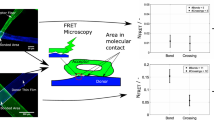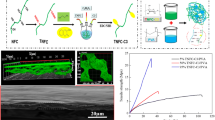Abstract
Cellulose nanofibers (CNFs) have great potential to be a layer in packaging materials because of their good barrier properties. When paper is coated with CNFs, they are difficult to distinguish from the base sheet. This issue creates challenges when trying to determine where CNFs migrate relative to the paper fibers during coating and drying. A three-dimensional analysis is possible by using confocal laser scanning microscopy (CLSM) if CNFs can be tagged with fluorescently active groups. In this study, CNFs were fluorescently tagged through adsorption of fluorescent dyes such as fluorescein isothiocyanate (FITC) and thioflavin by mixing with CNFs in their native suspension followed by purification. The adsorbed dye remained attached during typical coating procedures, low pH values, and high ionic strengths, but not for high pH and in contact with acetone. CNFs were also covalently tagged with FITC following methods reported in the literature as a comparison to already established methods for tagging cellulose nanocrystals. Images of never dried samples indicated that covalently tagging CNFs altered the state of the fines dispersion, while dye adsorption did not. Coatings of the adsorbed dye tagged CNFs on paper were successfully imaged by CLSM since the concentration of dye in the water phase was low enough to provide a good contrast between regions of CNFs and paper. With this method, the location and potential migration of CNFs coated on paper were successfully determined for the first time to the best of our knowledge. CNF based coatings with solids larger than 2.8% were found to have a distinct layer of CNFs at the paper surface with little CNFs penetrating into the paper structure, but lower solids result in significant penetration into the paper.







Similar content being viewed by others
References
Agnihotri VG, Giles CH (1972) The cellulose–dye adsorption process. A study by the monolayer method. J Chem Soc Perkin Trans 2(15):2241–2246
Ahola S, Österberg M, Laine J (2008) Cellulose nanofibrils—adsorption with poly(amideamine) epichlorohydrin studied by QCM-D and application as a paper strength additive. Cellulose 15:303–314
Amini E, Tajvidi M, Gardner DJ, Bousfield DW (2017) Utilization of cellulose nanofibrils as a binder for particleboard manufacture. BioResources 12(2):4093–4110
Arbatan T, Zhang L, Fang XY, Shen W (2012) Cellulose nanofibers as binder for fabrication of superhydrophobic paper. Chem Eng J 210:74–79
Asensio JL, Ardá A, Cañada FJ, Jiménez-Barbero J (2012) Carbohydrate–aromatic interactions. Acc Chem Res 46(4):946–954
Aulin C, Gällstedt M, Lindström T (2010) Oxygen and oil barrier properties of micro fibrillated cellulose films and coatings. Cellulose 17(3):559–574
Bae SH, Motomura H, Morita Z (1997) Diffusion/adsorption behaviour of reactive dyes in cellulose. Dyes Pigm 34(4):321–340
Barhate RS, Ramakrishna S (2007) Nanofibrous filtering media: filtration problems and solutions from tiny materials. J Membr Sci 296(1):1–8
Bhatnagar A, Sain M (2005) Processing of cellulose nanofiber-reinforced composites. J Reinf Plast Compos 24(12):1259–1268
Brodin FW, Gregersen OW, Syverud K (2014) Cellulose nanofibrils: challenges and possibilities as a paper additive or coating material–a review. Nord Pulp Pap Res J 29(1):156–166
Chen W, Enck S, Price JL, Powers DL, Powers ET, Wong CH, Kelly JW (2013) Structural and energetic basis of carbohydrate–aromatic packing interactions in proteins. J Am Chem Soc 135(26):9877–9884
de Morais Teixeira E, Corrêa AC, Manzoli A, de Lima Leite F, de Oliveira CR, Mattoso LHC (2010) Cellulose nanofibers from white and naturally colored cotton fibers. Cellulose 17(3):595–606
Dersch R, Steinhart M, Boudriot U, Greiner A, Wendorff JH (2005) Nanoprocessing of polymers: applications in medicine, sensors, catalysis, photonics. Polym Adv Technol 16(2–3):276–282
Ding Q, Zeng J, Wang B, Gao W, Chen K, Yuan Z, Tang D (2018) Effect of retention rate of fluorescent cellulose nanofibrils on paper properties and structure. Carbohyd Polym 186:73–81
Dong Shuping, Roman Maren (2007) Fluorescently labeled cellulose nanocrystals for bioimaging applications. J Am Chem Soc 129(45):13810–13811
Drnovsek T, Perdih A (2005) Selective staining as a tool for wood fibre characterization. Dyes Pigm 67(3):197–206
Du Y, Zang YH, Du J (2011) Effects of starch on latex migration and on paper coating properties. Ind Eng Chem Res 50(16):9781–9786
Ertl P, Rohde B, Selzer P (2000) Fast calculation of molecular polar surface area as a sum of fragment-based contributions and its application to the prediction of drug transport properties. J Med Chem 43:3714–3717
Fantini D, Costa L (2009) Dye, fluorophores and pigment coloration of nanofibers produced by electrospinning. Polym Adv Technol 20(2):111–121
Georgelis N, Yennawar NH, Cosgrove DJ (2012) Structural basis for entropy-driven cellulose binding by a type-A cellulose-binding module (CBM) and bacterial expansin. Proc Natl Acad Sci 109(37):14830–14835
Grate JW, Mo KF, Shin Y, Vasdekis A, Warner MG, Kelly RT, Wilkins MJ (2015) Alexa fluor-labeled fluorescent cellulose nanocrystals for bioimaging solid cellulose in spatially structured microenvironments. Bioconjug Chem 26(3):593–601
Hagen KG (1986) A fundamental assessment of the effect of drying on coating quality. Tappi J 69(1):93–96
Han J, Zhou C, Wu Y, Liu F, Wu Q (2013) Self-assembling behavior of cellulose nanoparticles during freeze-drying: effect of suspension concentration, particle size, crystal structure, and surface charge. Biomacromol 14(5):1529–1540
Hanson J, Neale SM (1934) The absorption of dyestuffs by cellulose. Part III. A comparison of the absorption of benzopurpurine 4B with that of Sky Blue FF. Trans Faraday Soc 30:386–394
Hinckley DA, Seybold PG, Borris DP (1986) Solvatochromism and thermochromism of rhodamine solutions. Spectrochim Acta Part A: Mol Spectrosc 42(6):747–754
Ho N, Weissleder R, Tung C-H (2006) Development of water-soluble far-red fluorogenic dyes for enzyme sensing. Tetrahedron 62:578–585
Honorato C et al (2015) Transparent nanocellulose-pigment composite films. J Mater Sci 50(22):7343–7352
Houtman CJ, Kitin P, Houtman JC, Hammel KE, Hunt CG (2016) Acridine orange indicates early oxidation of wood cell walls by fungi. PLoS ONE 11(7):e0159715
Jin L, Li W, Xu Q, Sun Q (2015) Amino-functionalized nanocrystalline cellulose as an adsorbent for anionic dyes. Cellulose 22(4):2443–2456
Kalita E, Nath BK, Deb P, Agan F, Islam MR, Saikia K (2015) High quality fluorescent cellulose nanofibers from endemic rice husk: isolation and characterization. Carbohyd Polym 122:308–313
Karakawa M, Chikamatsu M, Nakamoto C, Maeda Y, Kubota S, Yase K (2007) Organic light-emitting diode application of fluorescent cellulose as a natural polymer. Macromol Chem Phys 208(18):2000–2006
Kumar V, Koppolu VR, Bousfield D, Toivakka M (2017) Substrate role in coating of microfibrillated cellulose suspensions. Cellulose 24(3):1247–1260
Lavoine N, Desloges I, Dufresne A, Bras J (2012) Microfibrillated cellulose—its barrier properties and applications in cellulosic materials: a review. Carbohyd Polym 90(2):735–764
Linder M, Teeri TT (1997) The roles and function of cellulose-binding domains. J Biotechnol 57(1–3):15–28
Lorenz JN, Gruenstein E (1999) A simple, nonradioactive method for evaluating single-nephron filtration rate using FITC-inulin. Am J Physiol Renal Physiol 276(1):F172–F177
Maekawa M, Udaka M, Sasaki M, Tujii Y, Yoshida H, Kataoka T, Nango M (1989) Diffusion mechanism of direct dyes into a cellulose membrane: the structural effect of direct dyes on the adsorption rate. J Appl Polym Sci 37(8):2141–2152
Mahmoud KA, Mena JA, Male KB, Hrapovic S, Kamen A, Luong JH (2010) Effect of surface charge on the cellular uptake and cytotoxicity of fluorescent labeled cellulose nanocrystals. ACS Appl Mater Interfaces 2(10):2924–2932
Matthews JF, Skopec CE, Mason PE, Zuccato P, Torget RW, Sugiyama J, Himmel ME, Brady JW (2006) Computer simulation studies of microcrystalline cellulose Iβ. Carbohyd Res 341:138–152
Mousavi SM, Afra E, Tajvidi M, Bousfield DW, Dehghani-Firouzabadi M (2017) Cellulose nanofiber/carboxymethyl cellulose blends as an efficient coating to improve the structure and barrier properties of paperboard. Cellulose 24(7):3001–3014
Mousavi SM, Afra E, Tajvidi M, Bousfield DW, Dehghani-Firouzabadi M (2018) Application of cellulose nanofibril (CNF) as coating on paperboard at moderate solids content and high coating speed using blade coater. Prog Org Coat 122:207–218
Munir MM, Abidin MS, Rajak A (2015) A computer-based air flow control system for aerosol and filtration research. Appl Mech Mater 771:137–140
Murad MM (1999) Fluorescence analysis of acridine orange adsorbate at the water/N-heptane interface, bulk and interface. J Fluoresc 9(3):257–263
Nango M, Maekawa M, Katayama A, Kuroki N (1980) Dyeing of cellulose by direct dye in aqueous sodium alginate solution. J Appl Polym Sci 25(10):2159–2166
Neale SM, Stringfellow WA (1933) The absorption of dyestuffs by cellulose. Part I—the kinetics of the absorption of Sky Blue FF on viscose sheet, in the presence of various amounts of sodium chloride. Trans Faraday Soc 29(140):1167–1180
Nielsen LJ, Eyley S, Thielemans W, Aylott JW (2010) Dual fluorescent labelling of cellulose nanocrystals for pH sensing. Chem Commun 46(47):8929–8931
Ottesen V, Kumar V, Toivakka M, Chinga-Carrasco G, Syverud K, Gregersen ØW (2017) Viability and properties of roll-to-roll coating of cellulose nanofibrils on recycled paperboard. Nord Pulp Pap Res J 32(2):179–188
Pei A, Butchosa N, Berglund LA, Zhou Q (2013) Surface quaternized cellulose nanofibrils with high water absorbency and adsorption capacity for anionic dyes. Soft Matter 9(6):2047–2055
Pérez S, Mazeau K (2005) Conformations, structures, and morphologies of celluloses. In: Polysaccharides: structural diversity and functional versatility, pp 41–68
Purington E, Blakeley AR, Bousfield D, Gramlich WM (2017) Visualization of latex and starch in paper coatings by tagging with fluorescent dyes. Nord Pulp Pap Res J 32(03):395–406
Raj CR, Kamaraj M (2001) Emission of thioflavin T and its off-on control in polymer membranes. Photochem Photobiol 74(6):752–759
Richmond F (2014) Cellulose nanofibers use in coated paper. The University of Maine, Orono
Smith SA, Pretorius WA (2002) Spectrophotometric determination of pKa values for fluorescein using activity coefficient corrections. Water SA 28(4):395–402
Wang S, Gao W, Chen K, Zeng J, Xu J, Wang B (2018) An effective method for determining the retention and distribution of cellulose nanofibrils in paper handsheets by dye labeling. Tappi J 17(3):157–164
Willis HF, Warwicker JO, Standing HA, Urquhart AR (1945) The dyeing of cellulose with direct dyes. Part II. The absorption of chrysophenine by cellulose sheet. Trans Faraday Soc 41:506–541
Wood PJ (1980) Specificity in the interaction of direct dyes with polysaccharides. Carbohyd Res 85(2):271–287
Yang Q, Pan X (2010) A facile approach for fabricating fluorescent cellulose. J Appl Polym Sci 117(6):3639–3644
Zammarano M, Maupin PH, Sung LP, Gilman JW, McCarthy ED, Kim YS, Fox DM (2011) Revealing the interface in polymer nanocomposites. ACS Nano 5(4):3391–3399
Zhang L, Li Q, Zhou J, Zhang L (2012) Synthesis and photophysical behavior of pyrene-bearing cellulose nanocrystals for Fe3+ sensing. Macromol Chem Phys 213(15):1612–1617
Zhou C, Wu Q, Lei T, Negulescu II (2014) Adsorption kinetic and equilibrium studies for methylene blue dye by partially hydrolyzed polyacrylamide/cellulose nanocrystal nanocomposite hydrogels. Chem Eng J 251:17–24
Acknowledgments
We would like to thank the industrial sponsors of the University of Maine Paper Surface Science Program for input and support of this work. Research reported in this publication was also supported by the HSPH Center for Nanotechnology and Nanotoxicology and National Institute of Environmental Health Sciences of the National Institutes of Health (under Award Number, NIH Grant # U24ES026946) as part of the Nanotechnology Health Implications Research (NHIR) Consortium. The content is solely the responsibility of the authors and does not necessarily represent the official views of the National Institutes of Health. The engineered nanomaterials used in the research presented in this publication have been synthesized and characterized by the Engineered Nanomaterials Resource and Coordination Core of the NHIR consortium.
Author information
Authors and Affiliations
Corresponding author
Additional information
Publisher's Note
Springer Nature remains neutral with regard to jurisdictional claims in published maps and institutional affiliations.
Electronic supplementary material
Below is the link to the electronic supplementary material.
Rights and permissions
About this article
Cite this article
Purington, E., Bousfield, D. & Gramlich, W.M. Fluorescent dye adsorption in aqueous suspension to produce tagged cellulose nanofibers for visualization on paper. Cellulose 26, 5117–5131 (2019). https://doi.org/10.1007/s10570-019-02439-4
Received:
Accepted:
Published:
Issue Date:
DOI: https://doi.org/10.1007/s10570-019-02439-4




